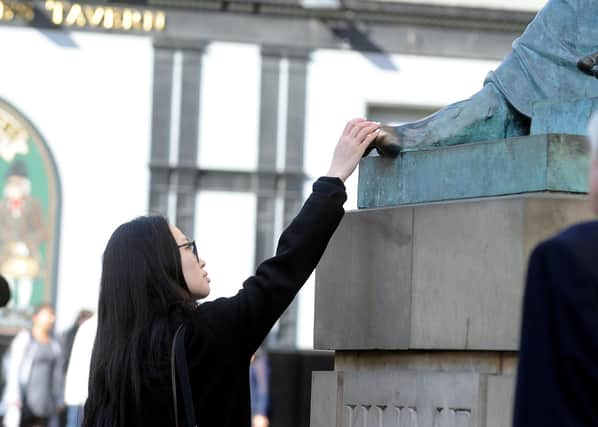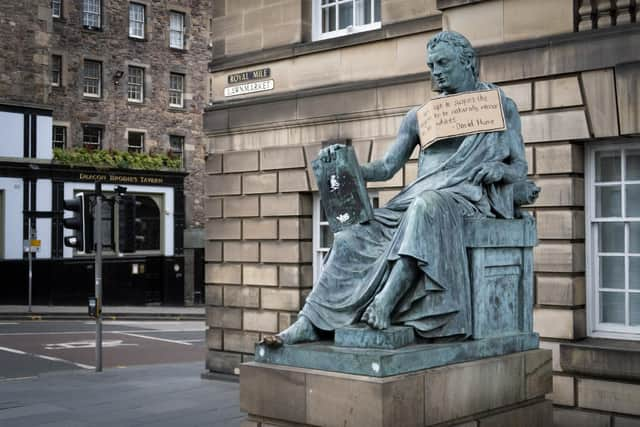David Hume Statue: Why do people rub the toe of Edinburgh's David Hume statue? 'Lucky toe' ritual, explained


The David Hume Statue on Edinburgh’s Royal Mile has become one of the popular stops on tours of the Old Town and the Capital’s rich history.
The towering nine foot bronze statue of the Scottish Enlightenment thinker has been in place at the top of Lawnmarket for almost 27 years, with many walking down the high street likely to see people crowding around the toga-draped David Hume to get a better look at the controversial figure.
Advertisement
Hide AdAdvertisement
Hide AdBut many are now taking part in one of the many local traditions celebrated in this popular, touristy part of the City, by rubbing the giant toe of the David Hume Statue which dangles over its huge plinth.


Here’s why people rub the toe of the David Hume Statue, when it was built and why it’s become a controversial monument in 21st century Edinburgh.
When was Edinburgh’s David Hume Statue built?
The David Hume Statue, located at the top of the Royal Mile in front of the High Court, was completed by Scottish sculptor Alexander ‘Sandy’ Stoddart as an almost 10ft bronze statue on Lawnmarket in 1995.
Considered to be one of the most influential philosophical thinkers of all time, Hume was born in Edinburgh in 1711 and died in his New Town home in 1776 at the age of 65.
Advertisement
Hide AdAdvertisement
Hide AdIt is one of many statues of famed Scots Enlightenment figures located throughout the Capital, with Stoddart’s statue of liberal philosopher Adam Smith nearby on the Mile, but stands out as perhaps one of the most striking in depicting the controversial philosopher in the manner of an ancient Greek hero.
Hume is sculpted in a toga with his chest and legs partially exposed, in a style typical of ancient Greek gods and icons which has since been interpreted as an ode to his influence and legacy on Western philosophy.
Why do people in rub the David Hume Statue’s toe?
The reason why people visiting or living in Edinburgh take to rubbing the now-golden toe of the David Hume Statue, as it lingers over the edge of its 15ft ‘HUME’-engraved plinth, is an ironic one.
While Hume himself became famed for his rejection of religion and superstition in favour of rationality and reason, as was ingrained in the Enlightenment generally, people rub the David Hume Statue’s toe as a good luck ritual, believing that this will bring luck or knowledge.
Advertisement
Hide AdAdvertisement
Hide AdIt was supposedly kickstarted as a local tradition by philosophy students hoping that rubbing the statue’s toe would see some of Hume’s wisdom rub off on them.
Some also believe that those paying a trip to the High Court building nearby rub the gleaming toe to help them win their case in court.
Speaking to The Scotsman in 2006, Stoddart said of the rise in students, locals and tourists rubbing the statue’s toe that he did not think David Hume, "the scourge of superstition and religiosity", would approve of having his toe rubbed for luck.
"The great thing is that it's so ironic that David Hume, who is the patron saint of all the atheists, should now have his toe adored," he said.
Advertisement
Hide AdAdvertisement
Hide AdJust like spitting on the nearby Heart of the Midlothian for luck, Mr Stoddart said he believed the action is one which would be passed down the generations.
"We are seeing the birth of an ancient tradition with this toe rubbing," he said. "What we are seeing is the future - they will be doing this 100 years from now."
Similar traditions exist throughout the world, with MPs touching the left foot of Winston Churchill's bronze statue in the members' lobby of the House of Commons for luck before going into the debating chamber turning gold and getting hairline fractures due to excessive touching.
Pilgrims to the Vatican ritually kiss the foot of a bronze 13th-century statue of St Peter, with so many people having kissed the right foot that St Peter's toes have now worn away.
Advertisement
Hide AdAdvertisement
Hide AdMeanwhile in Glasgow, a longstanding Saturday night tradition sees traffic cones placed on the head of Queen Street’s Duke of Wellington's statue.
Why is the David Hume Statue controversial?
David Hume, while heralded by many liberal thinkers and philosophers for his contribution to the Enlightenment and modern liberal thought, is also recognised today for his racist views and attitudes, particularly toward black people.
In his 1753 essay, Of National Characters, Hume wrote that he was “apt to suspect the Negroes [sic] to be naturally inferior to the whites”.
He added: "There scarcely ever was a civilized nation of that complexion, nor even individual eminent in action or speculation.”
Advertisement
Hide AdAdvertisement
Hide AdThe philosopher’s links to slavery have also been the subject of criticism and scrutiny, with Dr Felix Waldmann writing in The Scotsman: “Anyone with Hume’s intelligence would recognise the enormity of slavery.
"But Hume sought to benefit from it.”
Dr Waldmann added: “In Hume’s case, the history and morality of the matter is clear: Hume was an unashamed racist, who was directly involved in the slave trade.”
The David Hume Statue became part of Black Lives Matter protests in 2020, with protesters hanging a sign around the statue’s neck bearing his ‘Of National Characters’ quote as above.
Edinburgh University renamed its David Hume Tower, named after the philosopher, in 2020 after a petition by students to change the name of the building received almost 2,000 signatures.
A message from the Editor:
Thank you for reading this article. We're more reliant on your support than ever as the shift in consumer habits brought about by coronavirus impacts our advertisers.
If you haven't already, please consider supporting our trusted, fact-checked journalism by taking out a digital subscription.
Comment Guidelines
National World encourages reader discussion on our stories. User feedback, insights and back-and-forth exchanges add a rich layer of context to reporting. Please review our Community Guidelines before commenting.

